Preparing for a Hearing Test
Congratulations! You’ve reached an important step toward better hearing health. You may have noticed in the past few months or years that your hearing abilities have changed. You’ve made the right decision to schedule an appointment with us at Sound Solutions Audiology to have your hearing tested.
The idea of a test may create alarm or anxiety in some – but let us assure you that a hearing exam is a simple and painless procedure.
To prepare for your hearing test, compile information on your personal and family medical health, current medications you may be taking, details about your daily activities, and the times and places you experience difficulty hearing. This information will help your audiologist in the ongoing process toward better hearing health.

Consultation
The first step of a hearing test is a consultation with your audiologist. During this conversation, you’ll provide the information you’ve compiled about your medical history and lifestyle. This information gives us a better picture of your hearing needs and factors which may influence your hearing abilities.

Physical Examination
Following the consultation, your audiologist will perform a noninvasive examination of your ear area, using an otoscope. This instrument allows your audiologist to look inside your ear canals and determine whether there is any injury or damage to your ear canals or ear drums.
In some cases, hearing loss may be caused by impacted earwax, head/neck injury, or tumor. Your audiologist will look for these indicators during this examination.
Hearing Exams
There are several hearing exams that you may take, administered by your audiologist. Hearing exams test your ability to hear sounds at different volumes and frequencies, and determine your speech recognition abilities.
In the pure-tone test, you will be asked to wear headphones and listen for sounds. If and when you hear sounds, your audiologist will ask you to raise your hand or push a button. This exam determines your abilities to hear at different volumes and frequencies.
In the speech recognition test, your audiologist will read aloud a series of words and sentences and ask you to repeat them. This test is recorded in a percentage and determines your abilities to recognize and understand speech.
Middle ear testing and acoustic reflex testing (tympanometry) may be performed if needed. Tympanometry assists in the detection of fluid in the middle ear, perforation of eardrum or blockage of the ear canal. The test measures mobility of the eardrum. Acoustic Reflexes add information about the possible location of the hearing problem. A tiny muscle in the middle ear contracts when a loud sound occurs.
Reviewing Your Results
The results of your hearing exams are recorded in an audiogram, a visual representation of your hearing abilities by ear. Your speech recognition test results will be recorded in a percentage. From these results, your audiologist will determine the degree and configuration of your hearing loss, if it is present. The audiogram is an important tool in determining whether treatment is necessary.
Next Steps
The most common treatment for hearing loss is the prescription of hearing aids. Your audiologist will recommend a number of hearing aids based on your consultation and the results of the audiogram. Sound Solutions Audiology offers clients the option to test-drive hearing aids from four different manufacturers in order to determine the best fit. This process allows you to try hearing aids in real-life situations, in order to see which hearing aids are the best fit for your lifestyle. When you’ve selected your hearing aids, we customize them to meet your specific hearing needs and lifestyles.
